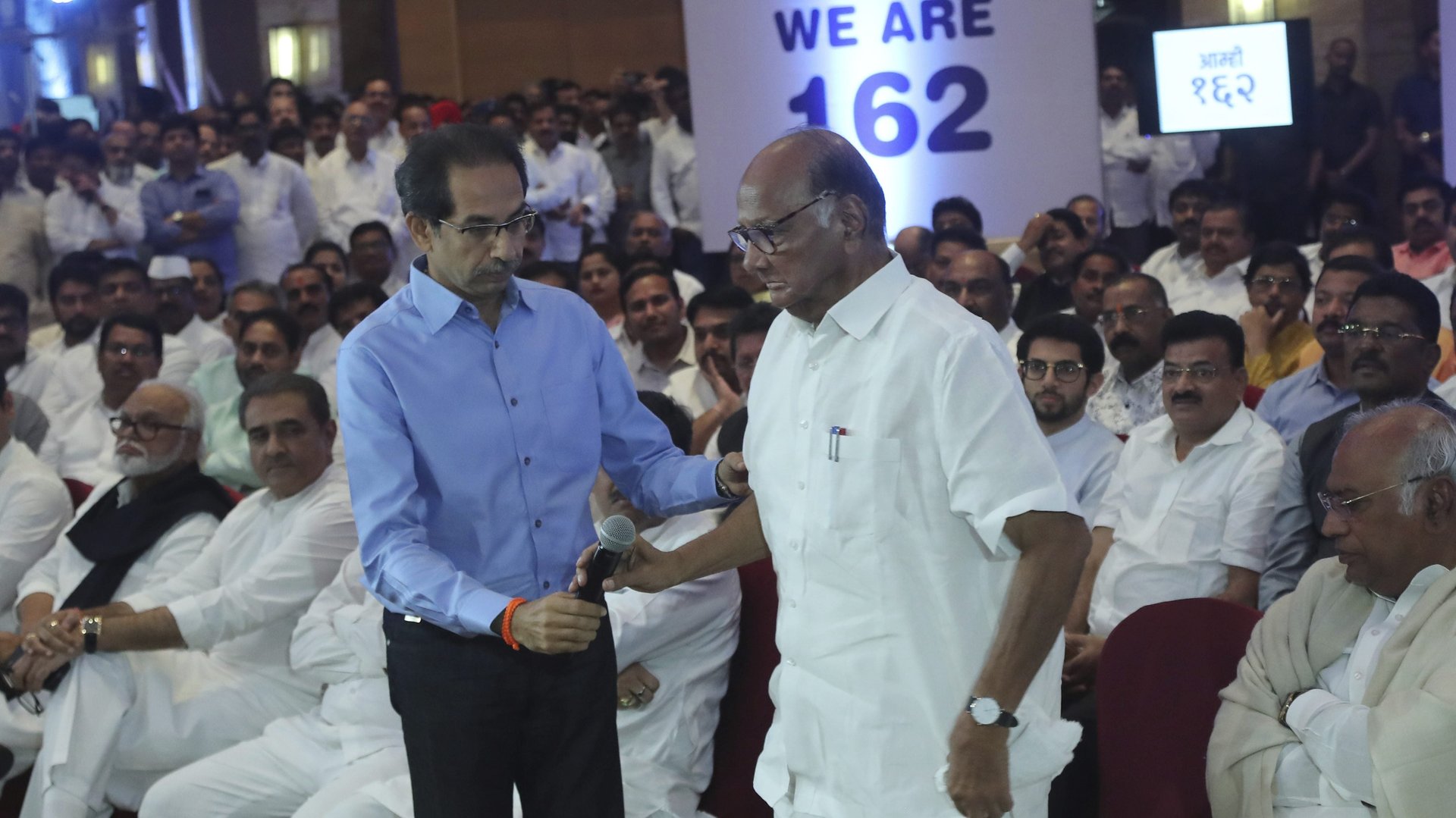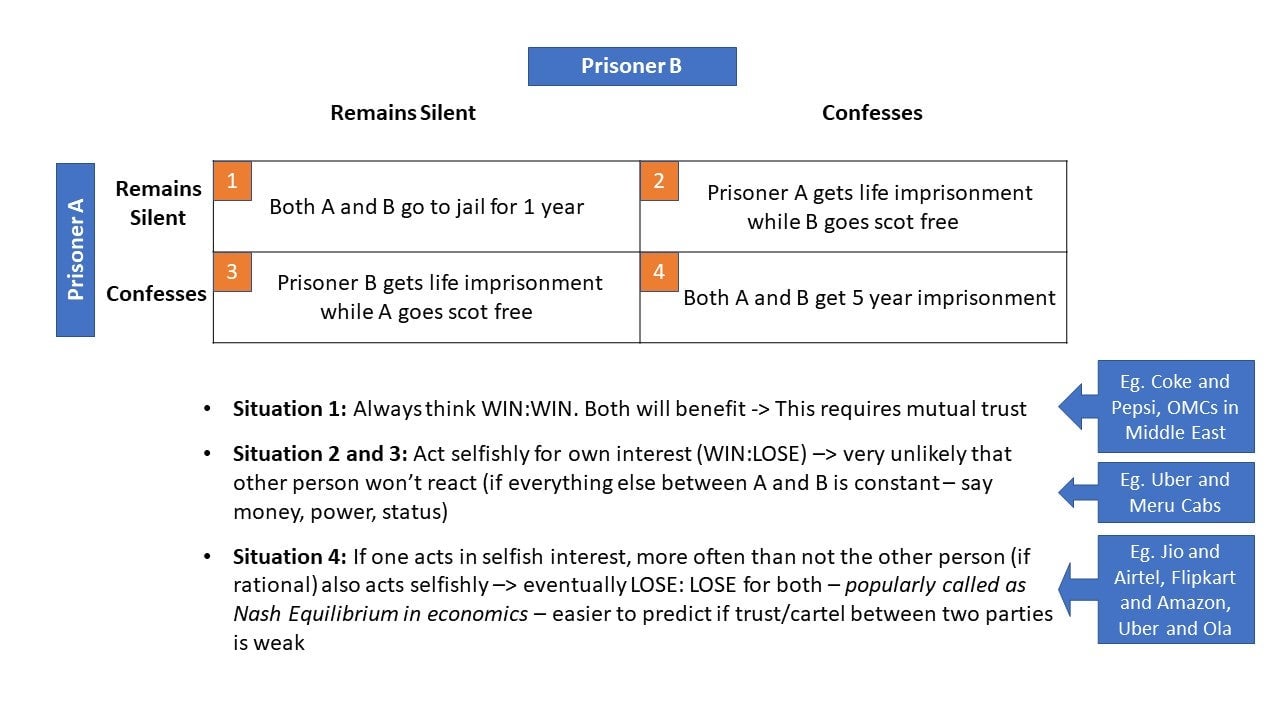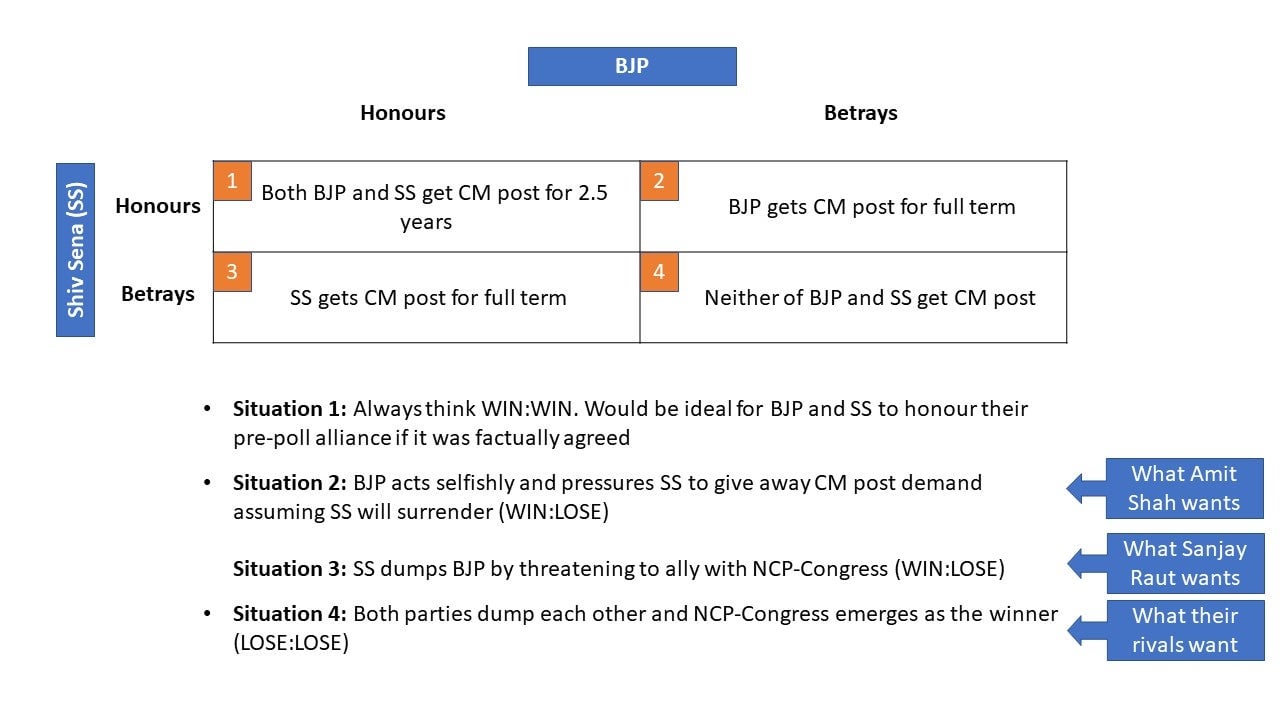The Maharashtra political chaos is equal parts Game of Thrones and Game Theory
If you are following the news lately, chances are you, too, are wondering what will be the conclusion of the drama that is unfolding bit by bit on the political stage of the crucial state of Maharashtra.


If you are following the news lately, chances are you, too, are wondering what will be the conclusion of the drama that is unfolding bit by bit on the political stage of the crucial state of Maharashtra.
The Bharatiya Janata Party (BJP) and Shiv Sena (SS) alliance won a comfortable mandate in the recent state elections (145+ seats required), with 105 and 56 seats respectively. However, the Shiv Sena made a claim for chief ministership citing a pre-poll agreement, while the BJP asserted that no such promise was made, and that coalition dharma mandates that the chief minister’s chair go to the bigger party. The parties then parted ways and here we are in a political stalemate.
It’s only ironical that the 30-year-old alliance broke apart when their foundational ideological campaign of the Ram Janmabhoomi movement reached its desired end. What should have further cemented the bonds, in fact, concluded in shattered foundations.
While we are still waiting to see which way this eventually turns, we thought it would be interesting to analyse the episode of events objectively. Curiously, this is a classic case of Game Theory. For starters, what is Game Theory? Let us understand the fundamentals here:
- Game Theory is the mathematical study of strategic decision making in conflict situations involving two or more parties. It provides a framework for the identification of possible scenarios and results.
- In this theory, interaction of conflict between two participants is called a game and the participants are called players.
- A game can be zero-sum (where one player’s gain is necessarily from other’s loss) or non-zero-sum (where gain may not necessarily lead to other’s loss).
Let us dive into the classic Game Theory illustration of the prisoner’s dilemma:
Prisoners A and B are on trial for a joint crime, in two separate cells. The prosecutor has no hard evidence to convict them. However, he has a plan to get a confession from them. He makes the same offer to them individually—confess or remain silent:
- If both remain silent, they face one year jail each
- If both confess, they face five years in jail each
- If one confesses and the other remains silent, the confessor goes scot-free, and the silent one gets a life sentence
Effectively, the final impact on the individual will be a result of their combined choices. Hence, to make a rational decision to minimise their punishment, they first need to think it through. What will the other person choose? And only then go on to think about what they will choose for themselves. Herein lies the heart of this theory.

The most ideal scenario for the duo is to face only one year of jail (situation one, win:win), yet the most probable scenario is both ending up with five years of jail (situation four, lose:lose). How so?
Say, A and B are allowed a minute’s meeting before the confession. Both promise to each other to remain silent. But, trying to outsmart and squeeze the maximum benefit of immediate freedom instead of a one-year jail term, both go back to their cells and confess instead (yeah, breach of trust and all that). Alternatively, even if they are not allowed to meet before the confession, none would want to remain silent and risk a lifetime jail, lest the other confesses. In both cases, whether outsmarting each other or hedging the risk, both end up facing five years term. This situation is called Nash Equilibrium.
A peculiar feature of Nash Equilibrium is that none of the parties involved are happy with the final result, yet inevitably they themselves choose it. Nash Equilibrium most likely holds true above unless, of course, the prisoners are strong allies and have a bond of unflinching bilateral trust. Thus, among others, Game Theory proves to be a great test of mutual trust between related parties, irrespective of the external situations. It is interesting to note that a mathematical model reveals deeply qualitative aspects of the interplay.
Now, what would happen if we extend Game Theory to the current political crisis in the BJP-Sena alliance?
The Maha game
Let us for once assume that the BJP did promise the Sena 50:50 sharing of the chief minister’s post. Using Game Theory, we imagine something like this happening out there:

Notably, BJP was initially confident of the status quo, by using pressure tactics to force the Sena to surrender the claim (situation two, win:lose). To BJP’s shock, Sena opted out of the 30-year-old alliance, claiming to ally with Nationalist Congress Party (NCP)-Indian National Congress (situation three, lose:win). The Sena, meanwhile, flirted with the NCP with eyes set on a full term in the chief minister’s chair for their Young Turk, Aditya Thackeray. The NCP patriarch Sharad Pawar played along, enough to create sparks but never a full-blown fire.
However, here’s where the Sena made a huge mistake: It put down the papers without getting the offer letter for its new job in hand. Eventually, it was unable to form the government on the governor’s invitation. In the process, it lost a host of things: i) A certain chance to rule Maharashtra ii) A stake in the union cabinet by getting its sole representative to resign on the whims of NCP iii) Aditya Thackeray’s claim to the chief minister’s chair, due to the NCP’s reservations for him being too young iv) Most importantly, a strong, long-standing and ideologically aligned partner.
While their chance to form government with the NCP is still open, they have lost their ground, to the extent that they had to proclaim post facto, that they are still open to go with the BJP. Even if they do form the government with NCP, the uncertainty of the alliance looms large over them from the recent examples set in Bihar and Karnataka. If they have to come back to the BJP some day, they will do so losing their position of strength in the erstwhile alliance.
As for the BJP, it lost a lot as well: i) A trusted, strong, and rare ideologically aligned ally ii) A smooth second term transition to continue the ongoing infrastructure projects without increase in time and cost iii) Its cooperative image of a big brother to its alliance partners iv) Most importantly, control of economically and financially crucial Maharashtra which can seriously dent the ruling party’s already floundering ambition of making India a five trillion economy till 2024-25.
From what we see, the NCP-Congress combine is clearly winning it so far, by widening the cracks in the NDA beyond Maharashtra. This might prove extremely useful in the 2024 national elections. The BJP and Sena have clearly landed in the Nash Equilibrium (situation two, lose:lose). Arguably, both are equally responsible for the fallout, no one can be cornered singularly. Both are unhappy ending up in their current situations, but both chose it. And we can safely say that all this happened largely because of one reason—a lack of mutual trust.
From the BJP’s side, the trust could have been strengthened by treating its ally like a peer, rather than like a subordinate party and by laying a counter-offer of the deputy chief minister’s chair. From the Shiv Sena’s side, the trust could have been strengthened by acknowledging the mandate and a stronger claim of its partner to the seat, according to the precedent set by their party patriarch, the late Bal Thackeray, in his times.
Like most frameworks, Game Theory does not provide “answers,” but a means to analyse the possibilities in a wholesome way. It is one of the most prominent frameworks across myriad human endeavours and has many applications in social sciences, economics, business, war, and other sciences.
We would go on to add that it is something we can imbibe in our lives. On this note, our personal key takeaway here is this: A win:lose situation in any relationship is temporary, and will sooner or later lead to a lose:lose situation. To make any relationship sustainable, it is important that it is largely a win:win situation. Trusting and trust-building is the foundation to this eventuality.
A version of this post first appeared on LinkedIn. We welcome your comments at [email protected].